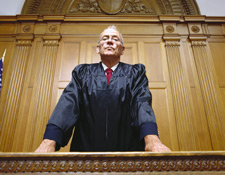- 01: Introduction
- 02: History
- 03: Propellants, Firearms, and Ammunition Development
- 04: Modern Firearms Manufacture
- 05: Small Arms Ammunition
- 06: Evidence Handling Procedures
- 07: Equipment and Instrumentation
- 08: Examination of Firearms
- 09: Cartridge and Shotshell Examination
- 10: Characterization and Evaluation of Fired Projectiles
- 11: Bullet Comparison and Identification
- 12: Gunshot Residue and Distance Determination
- 13: Toolmark Identification
- 14: Communicating Results
- Resources


Courtroom Personnel
Home > Communicating Results > Courtroom Testimony > Courtroom Personnel

The courtroom can be an intimidating place. The prosecutor or defense attorney should be able to help the examiner in this area. Being familiar with who’s who in the courtroom and their functions can ease apprehension. Court proceedings are normally staffed with the following:
- Judge (or Magistrate depending on jurisdiction).
Presides over the trial/hearing and holds ultimate authority over the proceedings that take place.
- Court Deputy or Bailiff.
Provides security in the courtroom. Bailiffs ensure order in the courtroom, announce the judge’s entry into the courtroom, call witnesses, and prevent the escape of the accused. Additionally, this individual supervises the jury when it is sequestered and controls public and media access to the jury.
- Court Clerk.
The court clerk provides administrative aid to the court during all proceedings and is normally responsible for handling and securing any evidence that is presented during the proceedings.
- Court Reporter.
Also called a court stenographer or court recorder, the court reporter’s function is to create a record of all that occurs during trial. This includes verbal comments made in the courtroom, testimony, objections, rulings of the judge, the judge’s instructions to the jury, arguments made by the attorneys, etc.
The following are self-explanatory:
- Prosecutor (also known as State Attorney, District Attorney, or Solicitor General)
- Defense Counsel
- Defendant
- Jury
The size of the jury will depend on a number of factors. Without addressing alternate jurors, there are three general jury size compositions: none, six, or twelve.
When there are no jurors (in the trial phase) the Judge acts as the jury. This is also referred to as a “bench trial.”
States can determine the size of criminal trial juries. Most states use juries composed of twelve persons and usually one or two alternates. Some states allow for juries fewer than twelve, but generally no fewer than six.




